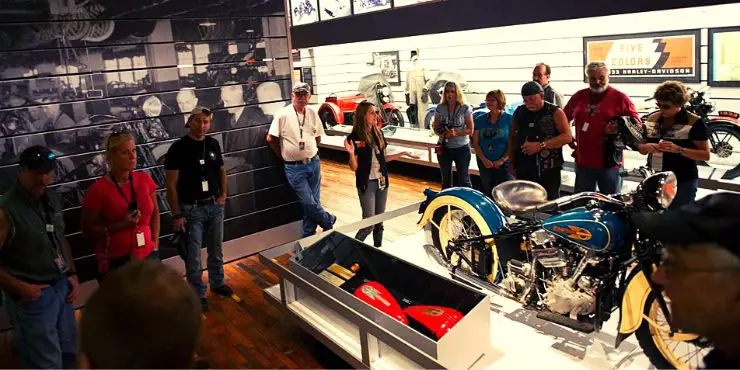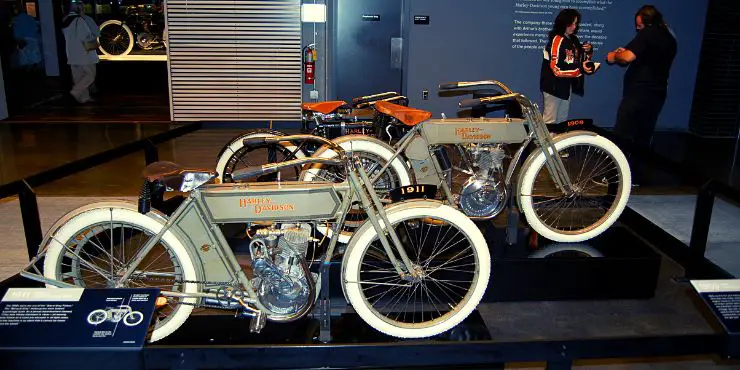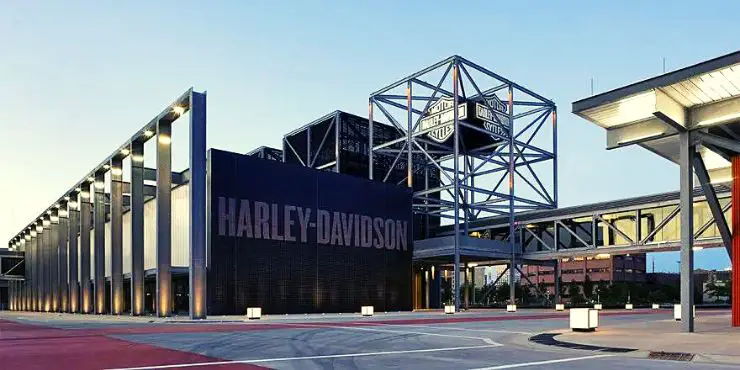Are you a Harley-Davidson enthusiast intrigued to know about the history of the iconic motorcycle brand by visiting the Harley-Davidson Museum? If yes, then this article will be of great help to you.
The Harley-Davidson Museum is located in Milwaukee, Wisconsin.
In this article, you’ll get to know all about the Harley-Davidson Museum, where is the Harley-Davidson Museum, the architecture of the Harley-Davidson Museum, the most historic parts of the Harley-Davidson Museum, and more. Continue reading to get all the answers that you are looking for.
Where is the Harley-Davidson Museum located?
The Harley-Davidson Museum is a historic American museum that is located in Milwaukee, Wisconsin, and it celebrates over a 100-year history of Harley-Davidson bikes. The 12,000-square meter (130,000 sq. ft.) three-building complex is spread across 81,000 square meters or 20 acres along the Menomonee River Bank. The museum contains over 450 Harley-Davidson bikes and hundreds of thousands of historic artifacts from the company’s near 120-year history.
The Harley-Davidson Museum officially opened to the public on July 12th, 2008, on a 20-acre site in the Menomonee Valley. The museum is built in a historically industrial area of Milwaukee. Before Harley-Davidson purchased this part of the city, this land was used by the Milwaukee Department of Public Works, Lakeshore Sand Company, and Morton Salt. A 1.2-meter (4-feet) layer of important soil was added to battle the contaminated soil. Moreover, new vegetation got planted to restore the landscape to a riparian state.
In late February 2006, the first designs for the museum were unveiled. These designs were created by James Biber (a partner at pentagram), Michael Zweck-Bonner (an associate at Pentagram), and their team. Abbott Miller, who was also a partner at Pentagram, designed the permanent exhibitions of the museum. The firm had designated the museum over a period of 8 years.
On June 1st, 2006, Harley-Davidson started the construction of the US $75 million (almost US $101 million in 2022 after price inflation) complex with a groundbreaking ceremony. Instead of the traditional golden shovel, this opening ceremony included the legendary Harley-Davidson dirt track racer Scott Parker, who broke ground by performing a burnout with a Harley-Davidson XL883R Sportster. The site also includes parking spaces for 500 cars and 1,000 motorcycles. The Museum’s façade even includes a 5.2 meter (17-feet) tall, steel Harley-Davidson sign.
The Architecture of the Harley-Davidson Museum
The Harley-Davidson Museum is an iconic, multi-building complex on the newly reclaimed brownfield industrial site that is close to downtown Milwaukee. The museum celebrates the rich history, art, and culture of the 100+-year-old company while creating a place for rallies and spontaneous gatherings that are the touchstone of the motorcycle community. Sitting on the peninsula surrounded by water, the urban design developed re-establishes the lost city grid, reflecting the site’s rich history in the new buildings. It also allows access to the water while defining space for future development.
All the while, it has created a place where the riders feel comfortable and where bikers who are new to the Harley-Davidson scene feel welcome.
The community of Harley-Davidson riders is particularly enthusiastic during rallies at towns like Laconia and Sturgis. The designers proposed that the Harley-Davidson Museum should learn from the organic arrangements by having an informal and formal component to the museum.
The outside component was dubbed the “Museum of the Street” and became the counterpart to the formal museum in the building’s interior. There is a broad orange stripe that emphasizes the rally space, whereas the Temporary Exhibition Space comes with large glass garage doors allowing the building to open to the street. These elements among others have helped make it a highly accessibly complex that is secure and manageable.

The structure of the museum leans heavily on the history of factors, as bikers refer to Harley-Davidson Motor Company as “the factory” in acknowledgment of the site’s industrial history. The designers have used the design logic of motorcycles for inspiration and as a result, the building will reflect the honesty of the bikes in design and pride. Concepts like the chronological road-like parade of bikes and racing gallery suspending in the space are beautifully crafted for exploiting the architecture, while they also create a strong narrative.
Sustainable design has proven to be an integral part of the museum for years. The Harley-Davidson Museum was built without LEED certification, but the sustainability is built in. Right from the greenest parking gardens of the area to the riverwalk lined up with native plants that help in controlling stormwater runoff to the light concrete roadways that reduce the heat island effect, this museum project displays its green credentials.
The entire land is filled with waterless urinals as well as solar-responsive light louvers as a part of the overall sustainable design. There might be a contradiction in the sustainable design for a motorcycle company, but bikes are among the most efficient gas-powered vehicles around, getting almost 50 mpg and parking four bikes in a single automobile space.
Harley-Davidson Museum exhibits
The Harley-Davidson Museum’s galleries exhibitions are spread throughout two floors, and there are temporary exhibits and the company’s archives. The complex even includes a restaurant, retail shop, café, and special event spaces. Also on display will be historic Harley-Davidson items that tell the iconic company’s story and history like photographs, clothes, posters, trophies, advertisements, video footage of vintage bikes, and more.
The Harley-Davidson Journey
Along the east side of the upstairs galleries, there is a series of interconnected galleries that exhibit the company’s chronological history. The galleries relate the motorcycle company’s history, from its origins in a 10 x 15 ft. wooden shack to its current status as arguably the top US motorcycle manufacturer that produces over 330,000 bikes each year. The centrepiece of this gallery is “Serial Number One”, the oldest Harley-Davidson bike in existence, and it is encased in glass. The glass closure sits in a floor-embedded, illuminated outline of the backyard shed that the company was founded in.
The Engine Room
The Harley-Davidson Museum’s second floor galleries start with the Engine Room. There is a knucklehead engine displayed disassembled into different pieces. The Engine Room even features many interactive touchscreen elements that show how historic Harley-Davidson motors like the Shovelhead and Panhead work.
Clubs and Competition
The Clubs and Competition gallery includes displays and information about the company’s racing history. The gallery also includes a section of a replica wooden track that is suspended in the air at a 45-degree incline. The track features vintage video footage of board track races and attacked 1920s-era racing bikes, the Harley-Davidson bikes that raced on board tracks at 160kmph (or 100mph). During those days, fatalities were common and this led to the banning of wooden board tracks for racing.
Tank Gallery
The upper floor of the museum exhibits include the Gas Tank Gallery, formerly a part of the Harley-Davidson 100th Anniversary Open Road Tour. This exhibit displays 100 of Harley’s most memorable tank graphics, spanning over seven decades, selected by the company’s styling department and reproduced on “Fat Bob” tanks.
Custom Culture
The Custom Culture gallery will cover the company’s impact on American and global culture. The centrepiece of the gallery is “King Kong”, a 4.0-meter (13 feet)-long, two-engine Harley-Davison bike customized by Felix Predko. The exhibit even features exact replicas of the customized Harley-Davidson motorcycles ridden by Dennis Hopper and Peter Fonda in the 1969 film “Easy Rider”, including Hopper’s “Billy Bike” and Fonda’s “Captain America” chopper. Two of each of these two choppers were created, while one of the “Captain America” bikes were destroyed during the film’s production.

Corporate Archives and Collections
The Harley-Davidson Motor Company’s corporate archives are housed on the museum’s grounds. The archives have supplied over 85% of the items that are on display in the museum. In 1915, Harley-Davidson’s founders decided to pull one bike from its production line to be preserved in an archive. Incredibly, one of the Harley-Davidson bikes on display was recovered on a beach in British Columbia after it was swept out to sea over 6,400 km (4,000 miles) away in a Tsunami that hit Japan back in 2011.
Conclusion
Thank you for reading. Hopefully, now you know a lot more about the historic Harley-Davidson Museum, where is the Harley-Davidson Museum, the architecture of the Harley-Davidson Museum, the most historic parts of the Harley-Davidson Museum, and more. The Harley-Davidson Museum is located in Milwaukee, Wisconsin, and it is a 12,000-square-meter three-building complex that stretches along the Menomonee River bank. Opened to the public on July 12th, 2008, on a 20-acre site in the Menomonee Valley, the museum contains over 450 different types of Harley-Davidson bikes, including the very first Harley-Davidson motorcycle, as well as thousands of artifacts from the motorcycle company’s 100+ year history.

